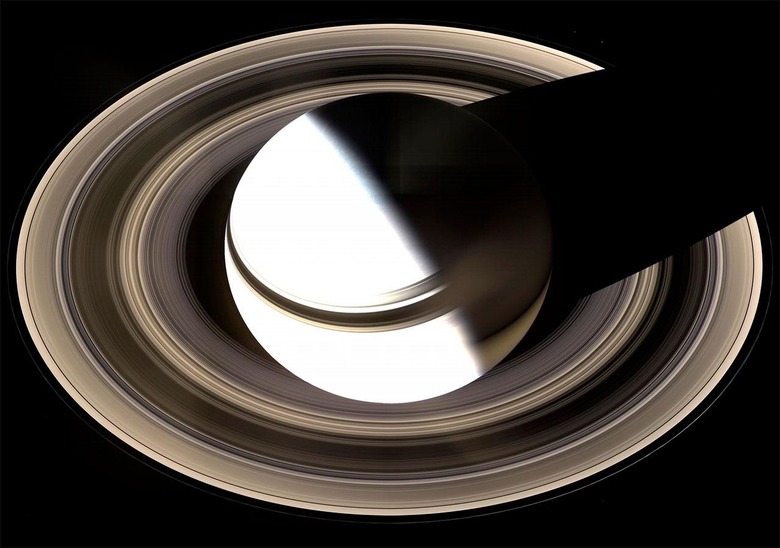See Saturn's Beauty As Cassini Crashes Into It
A 13-year journey ends this week as Cassini–Huygens crashes into the face of Saturn – and we get to see it all happen. At the end of this journey, NASA is celebrating with an E-Book called "The Saturn System : Through the Eyes of Cassini." This E-Book was made free this week, and from it we've got a few passages and big set of photos to share with you today. These are just a few of the 450,000 photos captured by Cassini on its journey from Earth to Saturn.
The book "The Saturn System : Through the Eyes of Cassini" was a collaborative development at NASA. Three teams collaborated on the book: NASA's Planetary Science Division (PSD), NASA's Jet Propulsion Laboratory (JPL), and the Lunar and Planetary Institute (LPI).
The HERO image in this article is cut from a much larger image of Saturn depicting the planet as it was in March of 2006. The tiny dot just below the line of rings is the moon Janus. Cassini captured this image on March 16, 2006, approximately 1.3 million miles (2 million kilometers) from Saturn. Image Credit: NASA/JPL-Caltech/Space Science Institute
BELOW: This image was captured with the specific intent of "taking in the rings in their entirety". As such, the camera exposure left the planet itself overexposed to the point of near-whiteness. Cassini captured this image on January 19, 2007, approximately 764,000 miles (1.23 million kilometers) from Saturn. Image Credit: NASA/JPL-Caltech/Space Science Institute.

BELOW: Next you'll see a monotone image showing some of Saturn's rings. As the book says, "The Cassini spacecraft stares toward Saturn through its gauzy veil of rings. The great ice-particle screen acts like a filter, attenuating the glare from the planet and making its high-altitude haze easy to see." Cassini took the image in visible blue light on November 4, 2006, at a distance of approximately 1 million miles (1.7 million kilometers) from Saturn. Image Credit: NASA/ JPL-Caltech/Space Science Institute.

BELOW: The photo below depicts the outer edge of Saturn's B Ring. These structures of ice (likely ice) are massive – some "tower as high as 1.6 miles (2.5 kilometers)" up from the planet's plane of rings. The book says that the rings are otherwise only "about 30 feet (10 meters) thick". "This view looks toward the southern, sunlit side
of the rings from about 32 degrees below the ring plane".

ABOVE: (Cont.) Cassini captured this image of a 750-mile long (1,200-kilometer-long) section along the outer edge of the B ring in visible light on July 26, 2009. The view was acquired at a distance of approximately 209,000 miles (336,000 kilometers) from Saturn. Image Credit: NASA/JPL-Caltech/Space Science Institute
Finally we've got a "Ball of Yarn" animation of the Cassini's orbital path around Saturn. Since 2004 the craft has been moving toward, around, and around, and around the planet many, many times. Credit: hNASA/JPL-Caltec.
The last day Cassini will fly will be September 15th, 2017. That's the day the craft will pass beyond NASA's sensors and crash into the body of Saturn. While the images we're seeing here are indeed spectacular, it is that last set of photos I most look forward to. Cross your fingers for swamp beings and alien skele-mares galore!
The book on Cassini's journey toward and around and crashing into Saturn can be downloaded in several formats through NASA this week. And we'll assume it'll be available there until further notice. NASA has the book listed for download as an iBook (for iOS devices like iPhone and iPad), MOBI for Kindle readers, a PDF, and an EPUB file for other E-Book readers.
